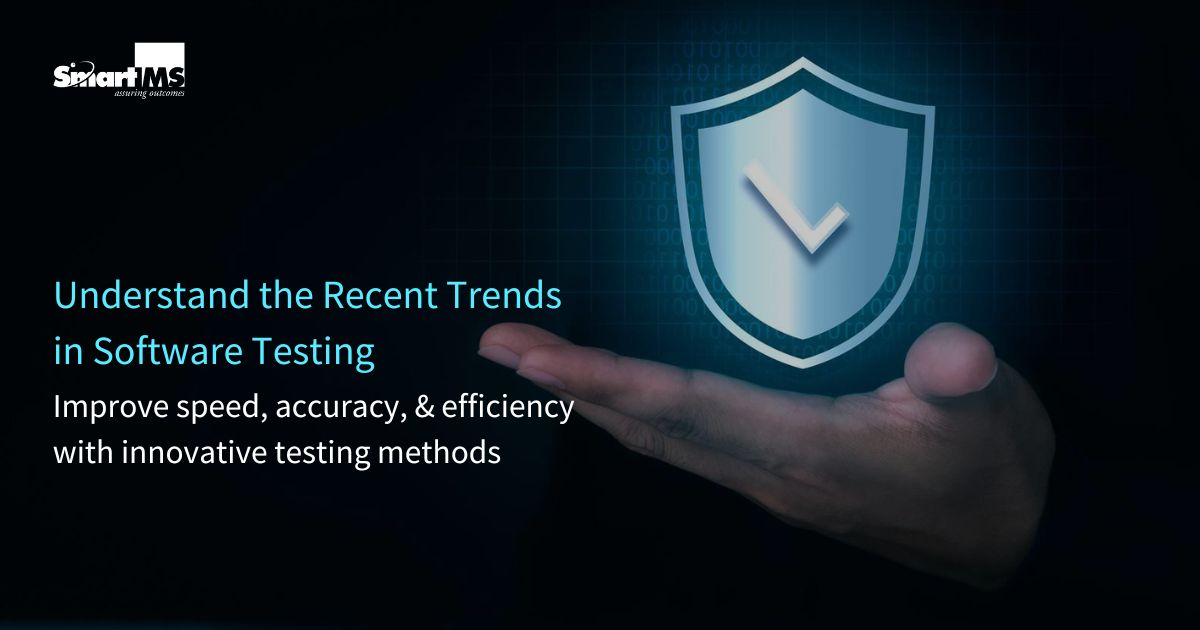The software testing landscape is rapidly evolving as businesses demand faster releases, higher quality, and seamless user experiences. In 2025, the role of software testing will extend beyond defect detection to ensuring security, performance, and compliance in an increasingly complex digital environment. Organizations that fail to keep up with modern testing trends risk slower time-to-market, inefficient workflows, and customer dissatisfaction.
With emerging technologies such as artificial intelligence (AI), DevSecOps, and cloud computing reshaping the industry, software testing is undergoing a transformation. Companies are adopting new methodologies, tools, and frameworks to improve automation, reduce risks, and enhance software reliability.
Here are the seven new trends in software testing trends that will define quality assurance in the year 2025.
- AI & Machine Learning in Testing (What’s New?)
AI and Machine Learning (ML) are reshaping the software testing landscape, making it more predictive and smarter than ever before. In 2025, AI-driven tools are no longer limited to basic test automation. These tools can now anticipate failures, analyze test execution patterns, and automatically optimize test coverage. AI-powered frameworks are continuously learning from past test cycles, predicting defects, and prioritizing critical tests, reducing the need for extensive manual intervention. AI tools now offer more sophisticated capabilities, like automating test case generation based on user behavior, ensuring comprehensive coverage with minimal human effort.
The big shift in 2025 lies in the integration of AI and ML into the full software development lifecycle. Predictive defect models help testers identify potential issues before they even arise, enabling teams to fix problems at the earliest possible stage. By leveraging AI, teams can eliminate redundant tests, optimize execution strategies, and ensure smarter test automation. As the tools evolve, AI-driven test automation will lead to faster development cycles, more accurate results, and ultimately, higher-quality software.
- Shift-Left vs. Shift-Right Testing
While Shift-Left Testing continues to dominate, the trend is evolving in 2025 with a growing emphasis on Shift-Right Testing. Shift-Left, which encourages testing early in the development lifecycle, remains crucial, but in 2025, companies are combining it with Shift-Right practices to ensure that both early and post-deployment testing are effectively integrated. Shift-Left focuses on identifying defects early, speeding up the development process and ensuring quality at every stage. This is enhanced by continuous integration (CI) tools and automated unit tests that validate code early.
However, the addition of Shift-Right Testing is redefining the approach. This method emphasizes testing post-deployment and in real production environments, ensuring applications maintain high performance and security even after release. With real-time monitoring and performance testing, Shift-Right guarantees that the software can handle real-world conditions, such as traffic spikes or security threats, that aren’t always detected in the testing phases. Together, Shift-Left and Shift-Right ensure a holistic approach to software quality.
- What’s New in Continuous Integration (CI) Testing in 2025
While Continuous Integration (CI) has long been a core part of modern development workflows, 2025 introduces smarter, AI-enhanced CI pipelines that automate and optimize the entire process. AI-driven tools now automatically prioritize the most important tests based on changes made to the code, analyzing the code’s impact in real-time. This approach reduces test redundancy, ensuring teams only run the necessary tests, saving both time and computational resources.
Additionally, scriptless automation tools are gaining traction in the CI pipeline. These tools allow testers, even those with little coding knowledge, to create automated tests. AI-enhanced CI tools also enable more efficient error detection and debugging, allowing teams to identify and fix integration issues before they reach production. With these innovations, CI pipelines in 2025 ensure faster, more reliable deployments without sacrificing test quality.
- AI-Powered Test Case Generation
Generating thorough and effective test cases has traditionally been a labor-intensive process, but AI is significantly changing this in 2025. AI-powered tools now analyze user behavior patterns and application logic to automatically create test scenarios. These AI systems generate test cases that mimic real-world user interactions, ensuring high-quality coverage with minimal manual input.
In addition to automating test creation, these tools now provide predictive test coverage, identifying areas of the software that are prone to defects and requiring more intensive testing. By leveraging historical defect data, AI tools can even recommend areas that require more detailed tests, reducing the chances of defects slipping into production. This shift to AI-generated test cases enables quicker release cycles and better-tested software with reduced human error.
- Security Testing in the DevSecOps Lifecycle
Security testing has traditionally been an afterthought, happening at the end of the development process. However, by 2025, security has become integrated directly into the development lifecycle through DevSecOps. Automated security tools now conduct continuous vulnerability assessments, penetration testing, and compliance checks throughout the entire development process. These tools not only identify vulnerabilities but can also automatically fix security flaws in real-time, reducing the time spent on manual fixes.
The Shift-Left security model ensures that vulnerabilities are addressed at earlier stages, but Shift-Right also plays a role. By embedding real-time security monitoring into live environments, teams can continuously validate security even after deployment. This approach minimizes the chances of data breaches and cyberattacks, making security an ongoing concern throughout development and post-deployment.
- Exploratory Testing and User-Centric Testing
While automated testing is invaluable, Exploratory Testing continues to play a key role, especially when it comes to validating the user experience (UX). In 2025, this approach has evolved with the help of AI and user data analytics. By incorporating real-world usage data, teams can now create more user-centric test scenarios, ensuring that the software meets actual customer needs and expectations.
Exploratory testing also goes beyond traditional methods by combining AI insights with human intuition, allowing testers to focus on areas that automated scripts might miss, such as accessibility or usability issues. This hybrid testing approach ensures that software is not only functional but also delivers an exceptional user experience. With the growing importance of UX, exploratory testing will be a critical part of ensuring high-quality applications in 2025.
- Cloud-Native Testing
The rise of cloud-native applications has brought new challenges in testing, particularly around scalability and performance. In 2025, cloud-native testing has advanced with cloud-based test platforms that enable organizations to test across multiple cloud environments, simulating various network conditions and traffic loads. This approach ensures that cloud applications are thoroughly validated for performance, security, and scalability before they go live.
Moreover, microservices testing has become an integral part of cloud-native testing. By leveraging cloud-based tools, companies can now test microservices in real-time to ensure seamless integration and performance under various conditions. As more organizations migrate to cloud environments, cloud-native testing will be essential for ensuring that applications can scale efficiently and remain reliable in complex cloud infrastructures.
Conclusion
The software testing landscape in 2025 will be defined by automation, AI-driven insights, security-first approaches, and user-centric testing. As organizations embrace DevSecOps, AI, and cloud computing, testing will become more intelligent, efficient, and integrated into the development process.
By adopting these new trends in software testing, businesses can accelerate software delivery, improve product quality, and enhance user satisfaction. Staying ahead of these trends is no longer optional—it’s essential for organizations looking to thrive in the ever-evolving digital ecosystem.
Stay ahead in software testing with the latest trends. Contact Smart IMS today to future-proof your QA strategy.



